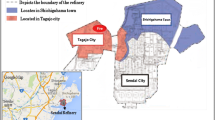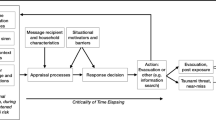Abstract
Based on a survey conducted with evacuees from the Fukushima radiation-affected region of Japan we examine intentions to return, eventually to the family homes. Many respondents do not intend to return, particularly those from tsunami-affected towns, but higher income households and those who evacuated to the same town are more likely to go back. Intentions are only weakly responsive to changes in ambient radiation levels and families with children are particularly unwilling to return to radiation affected areas, suggesting that the ongoing policy of active decontamination may have only a limited impact on eventual resettlement.


Similar content being viewed by others
Notes
Reuters, 28 Nov 2016, ‘Fukushima nuclear decommission, compensation costs to almost double: media’, www.reuters.com/article/us-tepco-outlook-idUSKBN13N03G . About 40% of these costs are compensation payments which would not normally be counted as costs in a benefit cost exercise. However, some part of the payments may be compensation for actual damages incurred.
Although not directly affected by the flooding, the tsunami cut off access to the nearest high school and other local government and commercial facilities. Hence we cannot say that the rate of return is simply due to perceived risk from radiation.
The omitted prefecture is Iwate which also suffered large-scale tsunami damage. Lying to the north of Miyagi prefecture measured radiation levels were only marginally affected by the Fukushima accident.
Note also that the figures for death-rates are closely related to other measures of damage such as the number of houses destroyed or damaged.
Although, Maderthaner et al. 1978 also find a positive relationship between distance to a nuclear reactor and risk perception and speculate that familiarity through proximity eliminates some element of fear. Venables et al. 2012 in a study of risk perception from nuclear power in the UK find a similar effect and cite a lengthy list of previous studies that also find a positive relationship between distance from industrial facilities and concern.
In theory we could use the same approach with the concern variable, but the instrument fails a weak instrument test ((Kleibergen-Paap rk Wald F statistic =0.056).
A well-known problem of linear probability models is that the predicted value of the dependent variables can, in theory, lie outside the interval [0,1] which would be incompatible with interpreting it as a probability. We check our estimates and find that only two out of 520 predicted values have a negative value (both −0.075) and none exceed 1.0.
In results that we do not include in the table, we also consider interaction terms between the concern variable and age, number of children and number of elderly, but there are no significant effects and the pattern of marginal effects for radiation level are not altered.
From Fukushima prefecture. http://www.pref.fukushima.lg.jp/sec/16025d/kako-monitoring.html . Site accessed June 2015.
References
Baker J, Shaw WD, Bell D, Brody S, Riddel M, Woodward RT, Neilson W (2009) Explaining subjective risks of hurricanes and the role of risks in intended moving and location choice models. Natural Hazards Review 10(3):102–112
Belasen AR, Polachek SW (2013) Natural disasters and migration, in: international handbook on the economics of migration. Edited by Amelie F. Constant, Klaus F. Zimmermann, Edward Elgar Publishing, Chapter 17:309–326
Chernobyl Forum (2006) Health, environmental and socio-economic impacts and recommendations to the governments of Belarus, the Russian federation and Ukraine: 2003–2005 Second revised version. World Health Organization (WHO)
Cho A (2014) Post-tsunami recovery and reconstruction: governance issues and implications of the great East Japan earthquake. Disasters 38(s2):s157–s178
Cutter S, Barnes K (1982) Evacuation behavior and three Mile Island. Disasters 6(2):116–124
Elliott JR, Pais J (2006) Race, class, and hurricane Katrina: social differences in human responses to disaster. Soc Sci Res 35(2):295–321
Falk WW, Hunt MO, Hunt LL (2006) Hurricane Katrina and new Orleanians' sense of place: return and reconstitution or 'Gone with the Wind'? Du Bois Review 3:115–128
FDMA (2015) Fire and disaster management agency, tohoku region pacific coast earthquake (East Japan great earthquake) damage report http://www.fdma.go.jp/bn/higaihou/pdf/jishin/149.pdf (in Japanese)
Fisman R, Svensson J (2007) Are corruption and taxation really harmful to growth? Firm level evidence. J Dev Econ 83(1):63–75
Fussell E, Sastry N, VanLandingham M (2010) Race, socioeconomic status, and return migration to New Orleans after hurricane Katrina. Popul Environ 31(1–3):20–42
Gill DA, Picou JS (1998) Technological disaster and chronic community stress. Soc Nat Resour 11(8):795–815
Groen JA, Polivka AE (2010) Going home after hurricane Katrina: determinants of return migration and changes in affected areas. Demography 47(4):821–844
Grote U, Engel S, Schraven B (2006) Migration due to the tsunami in Sri Lanka: analyzing vulnerability and migration at the household level; ZEF discussion papers on development policy, no. 106, University of Bonn
Hardie SML, McKinley IG (2014) Fukushima remediation: status and overview of future plans. J Environ Radioact 133:75–85. doi:10.1016/j.jenvrad.2013.08.002
IAEA (2011) Final report of the international mission on remediation of large contaminated areas off-site the Fukushima Dai-ichi FPP http://www.mofa.go.jp/mofaj/saigai/pdfs/iaea_mission_1110_en.pdf
Johnson EJ, Tversky A (1983) Affect, generalization, and the perception of risk. J Pers Soc Psychol 45(1):20–31
Kazama M, Noda T (2012) Damage statistics (summary of the 2011 off the Pacific coast of Tohoku earthquake damage). Soils Found 52(5):780–792
Kim J, Oh SS (2014) The virtuous circle in disaster recovery: who returns and stays in town after disaster evacuation? Journal of Risk Research 17(5):665–682
Kleinhesselink RR, Rosa EA (1991) Cognitive representation of risk perceptions: a comparison of Japan and the United States. J Cross-Cult Psychol 22(1):11–28
Kunreuther H, Linnerooth J (1984) Low probability accidents. Risk Anal 4(2):143–152
Landry CE, Bin O, Hindsley P, Whitehead JC, Wilson K (2007) Going home: evacuation-migration decisions of hurricane Katrina survivors. South Econ J 74(2):326–343
Lehmann H, Wadsworth J (2011) The impact of Chernobyl on health and labour market performance. J Health Econ 30(5):843–857
Leuraud K, Richardson DB, Cardis E, Daniels RD, Gillies M, O'Hagan JA, Hamra GB, Haylock R, Laurier D, Moissonnier M, Schubauer-Berigan MK, Thierry-Chef I, Kesminiene A (2015) Ionising radiation and risk of death from leukaemia and lymphoma in radiation-monitored workers: an international cohort study. Lancet Haematology 2(7):e276–e281
Maderthaner R, Guttmann G, Swaton E, Otway HJ (1978) Effect of distance upon risk perception. J Appl Psychol 63(3):380
Managi S and Guan D (2017) Multiple disasters management: lessons from the Fukushima triple events. Economic Analysis and Policy 53:114–122
Moriya M (2011) Remediation Efforts in Japan, Presentation at OECD “International Symposium on Decontamination: Towards the Recovery of the Environment” http://www.oecd-nea.org/press/2011/NEWS-07-presentations.html
Munro A (2013) The economics of nuclear decontamination: assessing policy options for the management of land around Fukushima dai-ichi. Environmental Science and Policy 33(0):63–75
NAIIC (2012) The official report of the Fukushima Nuclear Accident Independent Investigation Commission Available: http://www.nirs.org/fukushima/naiic_report.pdf
Nakayachi K, Yokoyama HM, Oki S (2015) Public anxiety after the 2011 Tohoku earthquake: fluctuations in hazard perception after catastrophe. Journal of Risk Research 18(2):156–169
Onuma H, Shin LJ, Managi S (2017) Household preparedness for natural disasters - impact of disaster experience and implication for future disaster risks in Japan. International Journal of Disaster Risk Reduction 21:148–158
Orita M, Hayashida N, Urata H, Shinkawa T, Endo Y, Takamura N (2013) Determinants of the return to hometowns after the accident at Fukushima Dai-ichi nuclear power plant: a case study for the village of Kawauchi. Radiat Prot Dosim 156(3):383–385
Paul BK (2005) Evidence against disaster-induced migration: the 2004 tornado in north-central Bangladesh. Disasters 29(4):370–385
Paxson C, Rouse CE (2008) Returning to New Orleans after hurricane Katrina. Am Econ Rev 98(2):38–45
Rofi A, Doocy S, Robinson C (2006) Tsunami mortality and displacement in Aceh province, Indonesia. Disasters 30(3):340–350
Saito M (2015) Political economics of disaster recovery. Nihon-Hyoronsha, Tokyo
Slovic P (1987) Perception of risk. Science 236(4799):280–285
Slovic P (1996) Perception of risk from radiation. Radiat Prot Dosim 68:165–180
Soffer Y, Schwartz D, Goldberg A, Henenfeld M, Bar-Dayan Y (2008) Population evacuations in industrial accidents: a review of the literature about four major events. Prehospital Disaster Medicine 23(3):276–281
Spencer N, Urquhart M (2016) Hurricanes? Let's make a move, CESifo working paper no. 6081
Stephan V (2005) Chernobyl: poverty and stress pose 'bigger threat' than radiation. Nature 437(7056):181–181
Strand P, Brynildsen L, Harbitz O, Tveten U (1990) Measures introduced in Norway after the Chernobyl accident: a cost-benefit analysis. International Atomic Energy Agency (IAEA):IAEA
Suzuki I, Kaneko Y (2013) Japan’s disaster governance: how was the 3.11 crisis managed? Springer Science & business media, New York
Tubiana M, Feinendegen LE, Yang C, Kaminski JM (2009) The linear no-threshold relationship is inconsistent with radiation biologic and experimental data. Radiology 251(1):13–22
UNSCEAR (2008) Sources and Effects of Ionizing Radiation, United Nations Scientific Committee on the Effects of Atomic Radiation, UNSCEAR 2008 Report, Volume 1
Venables D, Pidgeon NF, Parkhill KA, Henwood KL, Simmons P (2012) Living with nuclear power: sense of place, proximity, and risk perceptions in local host communities. J Environ Psychol 32(4):371–383
Waldenberger F, Eilker J (2014) The economic impact of the Tohoku earthquake. East Asia 9(2.0):0-1
Yang D 2008. Risk, migration, and rural financial markets: evidence from earthquakes in El Salvador. Social Research 75(3):955–992
Zhang H, Yan W, Oba A, Zhang W (2014) Radiation-driven migration: the case of Minamisoma City, Fukushima, Japan, after the Fukushima nuclear accident. Int J Environ Res Public Health 11(9):9286–9305
Acknowledgements
We would like to thank Shinya Horie for survey preparation. This research was funded by the Grant-in-Aid for Specially Promoted Research [26000001B]; the Ministry of Education, Culture, Sports, Science and Technology, and S16 of the Ministry of the Environment, Japan. The results and conclusions of this article do not necessarily represent the views of the funding agencies.
Author information
Authors and Affiliations
Corresponding author
Rights and permissions
About this article
Cite this article
Munro, A., Managi, S. Going Back: Radiation and Intentions to Return amongst Households Evacuated after the Great Tohoku Earthquake. EconDisCliCha 1, 77–93 (2017). https://doi.org/10.1007/s41885-017-0001-6
Received:
Accepted:
Published:
Issue Date:
DOI: https://doi.org/10.1007/s41885-017-0001-6




